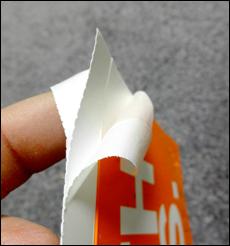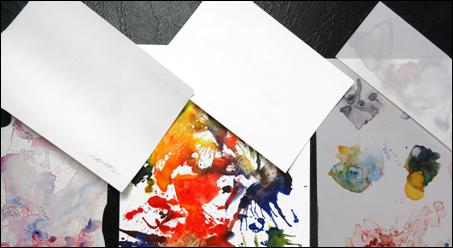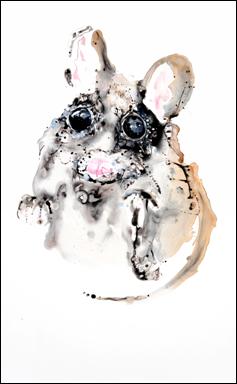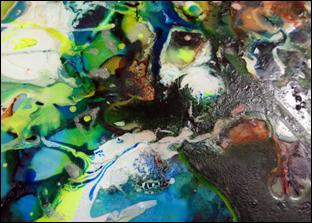 Photo 1
Photo 1
Yupo consists of three extruded polypropylene layers fused together into a sheet. Thin top and bottom layers are fused to a heavier weight center core.
Synthetic papers are known as durables, synthetics or plastics, but are not paper. They include various grades of plastics including polyvinyl chloride (PVC), polystyrene, polyethylene, polypropylene and polyester/nylon. These synthetics are more familiar to us by their manufactured products and names: foamboard is polystyrene; Tyvek is polyethylene which feels like fabric, may be sewn or glued and is used mostly for packaging, but may be painted with acrylic; Yupo is polypropylene, which is satin-coated and feels like a coated paper; Evolon is polyester/nylon that is tear proof, lint-free and doesn't stretch or expand, used for printing and painting; and TerraSkin is calcium carbonate/polyethylene resin for printing and art that is water and tear resistant.
Having been developed as an eco-friendly wood alternative, synthetic papers were originally designed to be more green for the printing/signage industry, and since they are receptive to paint, it stands to reason that artists would embrace them too. All of these products are currently being sold by art, paper and printing suppliers as roll, single sheet, tablet, and/or sketchbooks, the most popular being Yupo.
Once completed, synthetic original paintings still need to be protected and configured into a wall display, but here is where things vary from the traditional. Artists may still mat, glaze and frame synthetic paper as they would any watercolor paper, but may also opt for an open-air float frame, cradled box, or mounting to some other rigid substrate for the no-frame look. And the larger the art—Yupo is available 60wide x 10 yds—the more contemporary the presentation becomes, occasionally requiring cleats or stand-offs as hanging hardware.
About Yupo
Yupo is a neutral pH, ultra-smooth, non-absorbent/waterproof, 100% recyclable, tear- and chemical-resistant, tree-free sheet with properties that make it perfect for a variety of marketing, design, packaging and labeling needs. Yupo is extruded from polypropylene pellets. There are three layers to the material: sheer surface (top) and base (bottom) layers formed during the extruding process, then bonded to a heavier central core which create a dimensionally stable substrate. These layers may be split if not handled correctly, which may occur most frequently when attempting to remove ATG. (photo 1) It is available in various text and cover weights—translucent and opaque—with 74# white, 144# white and 104# translucent being favored by artists for watercolor, gouache, alcohol ink, and acrylic. (photo 2) Alcohol ink and acrylic are permanent and do not wash off.
 Photo 1
Photo 1
Yupo consists of three extruded polypropylene layers fused together into a sheet. Thin top and bottom layers are fused to a heavier weight center core.
 Photo 2
Photo 2
(L-R) TerraSkin made of calcium carbonate/polyethylene resin; Yupo polypropylene opaque white 74# and 144#; and Yupo translucent 104#.
Unlike conventional papers, the Yupo surface may be totally wiped clean to restore the original white of the sheet long after water based color has dried, so painting is sometimes created by painting the negatives, applying pigment then taking away color to create the finished image. Challenge Yourself by Tina Dille is a 26x40" watercolor on opaque white Yupo. (photo 3)
 Photo 3
Photo 3
"Challenge Yourself" mouse by Tina Dille is a 26x40" is watercolor on opaque white Yupo. The vast expanse of white negative space surrounding the image is a formal part of the painting and cannot me cut or covered. This smooth unpainted white area allows visible undulations from adhesive application or substrate choice to be visible.
The artist has left a vast expanse of negative white—unpainted paper—surrounding the mouse as an integral part of the completed painting, as often occurs with letter press and hand-pulled lithographs. This smooth unpainted white area is what allows undulations from adhesive application or substrate choice to be visible after mounting. When the painting color or texture fills the entire page, mounting irregularities are better camouflaged. The second Dille sample shows heavily textured mixed media on translucent Yupo mounted to ⅛" hardboard. (photo 4)
 Photo 4
Photo 4
This heavily textured mixed media by Tina Dille on translucent Yupo better camouflages paper irregularities and color ghosting once mounted to ⅛" hardboard.
Removing ATG
Artists often use ATG two-sided tape to hold their Yupo to a painting board. Since Yupo is a multiple ply laminated sheet, it the bottom layer may be split from the core if the P-S adhesive is not softened or dissolved with a solvent prior to removal. Chemical solvent does not impact water base pigment, and water as a solvent won't impact chemical base pigments (alcohol ink), but solvents near original art is not something a framer should be considering.
A recent project came in where the artist had mounted the completed painting with double-sided tape to a piece of slate as part of their no-frame look. When it was decided that heavy slate was not easy to display, they attempted to peel the Yupo from the stone—rather than using a solvent—and the back layer of polypropylene remained adhered splitting the layers at the corner. If there remains a layer of paper on the back corners of the Yupo, sometimes Windex or Dirtex helps remove the adhesive tape as a gentle solvent. However it is the ammonia in the contents that works as the solvent and will also remove dirt, grease and latex (acrylic) paint or sealer, so framer beware. All too often repairs end up being far worse than the original damage. These details should always be noted in the condition report written when the original is first brought in, and should always be pointed out as damage to the client or artist. The divot created by the loss of the paper layer could show after mounting.
Archival (extended-term) Mounting
Sometimes you can't have it both ways. Yupo may be sealed, permanently mounted and displayed with stable inert materials and no frame; or it may be preservationally framed with hinges, rag mats, glazing and be fully reversible. The biggest rule never to break is that original art should not be mounted, but the raw, unpainted, virgin paper may be mounted. Photos are best displayed when mounted. Rippled or cockled photos just look wrong and Yupo may end up being the same.
Synthetics do not absorb or react with other materials to create a new chemical reaction, rendering them stable and inert, which is good, but since that cannot absorb the adhesive options are limited. Artists often demand archival mounting, stating they want acid-free, 100 year term bonding that is non-invasive. It is not the adhesive that makes a mount non-archival, but the adhesive residue that remains if removed. Invasive mounting is non-preservation when adhesive is remaining in the art once removed, but since polypropylene cannot absorb, it would remove cleanly.
Dry mounting any valuable original art, photograph, or document is not a recommended procedure, but sometimes it may be the only way. Museums are accepting face mounted digital art these days, directly from artists, but generally not creating that mount themselves. When the artist wishes to display art unglazed, floated, or applied to a cradled box it requires a mounting method to hold it to the substrate of choice.
Static Mounting
Basic non-starch paste preservation methods—such as corner pockets or edge strips—are a mount option, but static and cockling may be a resulting issue particularly with larger pieces, and flange hinging across the top may cockle the polypropylene. Yupo is prone to collecting static so maintaining at least 42% relative humidity helps control it.
Think of Yupo like polyester Cibachrome, different plastic base but similar issues. Cibachromes easily show substrate orange peel when mounted to a substrate, so might Yupo.Unfortunately the benefits of static mounting as a preservation application will not work with Yupo as the polypropylene does not maintain a charge adequate to hold to acrylic sheet the same as polyester.
Though dimensionally stable, hinged and matted Yupo may bow and react to in-room static allowing the sheet to buckle into the window of the mat. When white unpainted portions of Yupo paper are allowed to touch the glass, dark grey splotches appear. And since artwork should never touch glass, efforts must be made to establish an adequate space between the art and the glazing, which may mean mounting. It is a known fact that paper will expand and contract with moisture and temperature changes, the same is true with polypropylene.
Fixatives
Krylon Gallery Series UV Archival Varnish is a favored product for sealing, so originals may be mounted and displayed with no glazing. Open-air paintings on Yupo require sealing by the artist to protect the medium, but one under glass with mats not be sealed. If unsealed, Yupo should be treated as gently as a pastel. And like a pastel, artists are resistant to applying fixatives as they can alter the surface pigment colors.
At times they are only sealed when being taken to a framer to help protect it from fingerprints and accidental damage. Yupo is highly susceptible to fingerprints, and once a fingerprint has been sealed over, it will remain forever, so extreme care should be taken when handling Yupo paper and wearing gloves is highly advised.
It is an acknowledged fact that white Yupo paper will yellow over time when exposed to UV light. So do not place the artwork in direct sunlight or expose it to florescent lighting and all glazing, whether glass or acrylic, should be UV filtering to minimize and slow the yellowing damage.
Afterthoughts
Watercolor paintings on Yupo should be delivered in a clear plastic sleeve, possibly with a glassine cover. If they are not protected when delivered, again treat as a cibachrome and place it under a Mylar sheet prior to designing. Always fill out a condition report and always discuss all of the options.
Look for "Mounting Synthetic Papers - Part 2in the PFM September 2015 issue.
Original artwork—Challenge Yourself compliments of Tina Dille, artist. http://DilleyArt.com
END
Copyright © 2015 Chris A Paschke
Resources—Items
http://legionpaper.com—Yupo distribution and information
http://neschen.com—Neschen gudy 870, 831, 802
http://dkgroup.com—Expression Wide Format Laminators and SuperStick adhesives
http://kooltack.com—InstaMount Gatorboard, InstaMount Mighty Tough
http://codamount.com—Laminators, Cold-Mount Gatorboard
http://drytacusa.com—JetMounter Roll Laminators, HT pressure-sensitive adhesives
http://encoreproducts.com—MightyCore, MightyBull
http://standoffsystems.com—Gyford Standoffs
http://framewareinc.com—Standoffs
For more articles on mounting basics look under the mounting section in Articles by Subject.
Additional information on all types of mounting is found in:
The Mounting and Laminating Handbook, Second Edition, 2002,
The Mounting And Laminating Handbook, Third Edition, 2008 and
Creative Mounting, Wrapping, And Laminating, 2000 will teach you everything you need to know about getting the most from your dry mount equipment and materials as an innovative frame designer.
All books are available from Designs Ink Publishing through this website.
Chris A Paschke, CPF GCF
Designs Ink
Designs Ink Publishing
785 Tucker Road, Suite G-183
Tehachapi, CA 93561
P 661-821-2188
chris@designsinkart.com